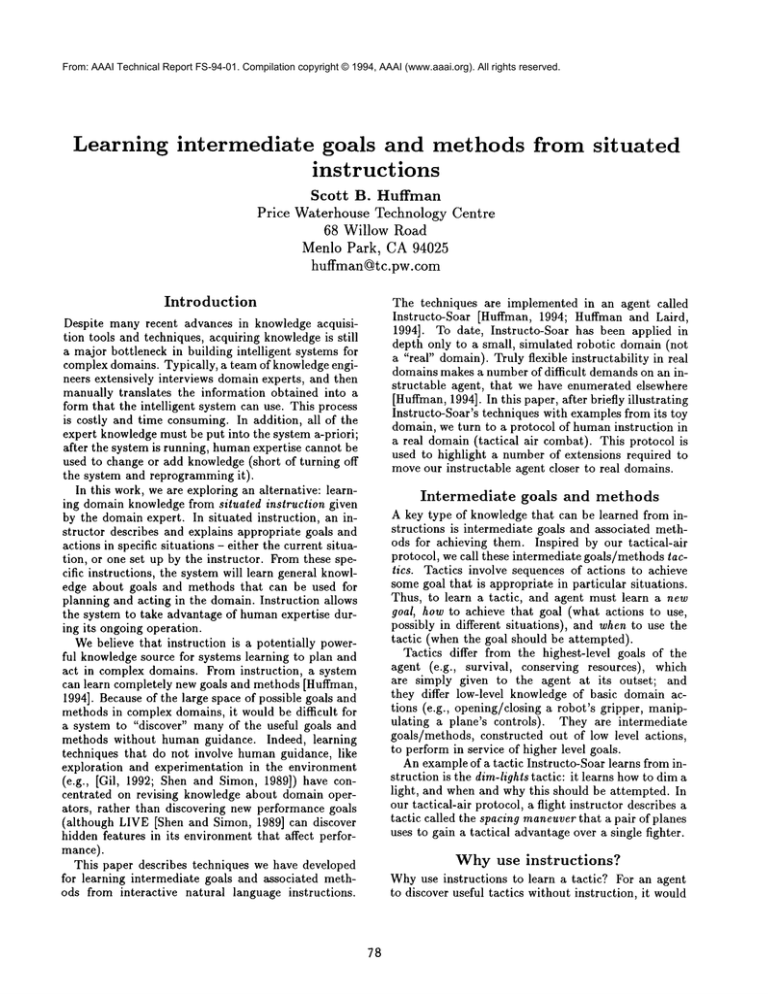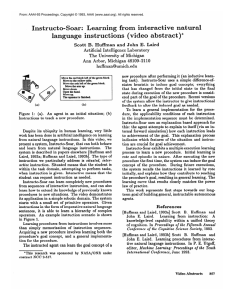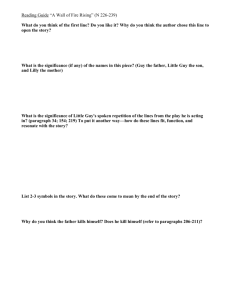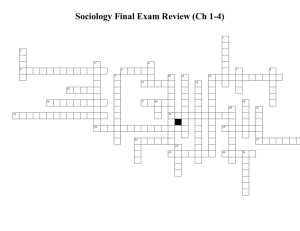
From: AAAI Technical Report FS-94-01. Compilation copyright © 1994, AAAI (www.aaai.org). All rights reserved.
Learning
intermediate
Price
goals and methods from situated
instructions
Scott
B. Huffman
Waterhouse Technology
Centre
68 Willow Road
Menlo Park, CA 94025
huffman@tc.pw.com
Introduction
The techniques are implemented in an agent called
Instructo-Soar [Huffman, 1994; Huffman and Laird,
1994]. To date, Instructo-Soar has been applied in
depth only to a small, simulated robotic domain (not
a "real" domain). Truly flexible instructability in real
domains makes a number of difficult demands on an instructable agent, that we have enumerated elsewhere
[Huffman,1994]. In this paper, after briefly illustrating
Instructo-Soar’s techniques with examples from its toy
domain, we turn to a protocol of humaninstruction in
a real domain (tactical air combat). This protocol
used to highlight a number of extensions required to
moveour instructable agent closer to real domains.
Despite many recent advances in knowledge acquisition tools and techniques, acquiring knowledgeis still
a major bottleneck in building intelligent systems for
complex domains. Typically, a team of knowledgeengineers extensively interviews domain experts, and then
manually translates the information obtained into a
form that the intelligent system can use. This process
is costly and time consuming. In addition, all of the
expert knowledgemust be put into the system a-priori;
after the system is running, humanexpertise cannot be
used to change or add knowledge (short of turning off
the system and reprogramming it).
In this work, we are exploring an alternative: learning domain knowledge from situated instruction given
by the domain expert. In situated instruction, an instructor describes and explains appropriate goals and
actions in specific situations - either the current situation, or one set up by the instructor. From these specific instructions, the system will learn general knowledge about goals and methods that can be used for
planning and acting in the domain. Instruction allows
the system to take advantage of humanexpertise during its ongoing operation.
Webelieve that instruction is a potentially powerful knowledge source for systems learning to plan and
act in complex domains. From instruction,
a system
can learn completely new goals and methods [Huffman,
1994]. Because of the large space of possible goals and
methods in complex domains, it would be difficult for
a system to "discover" many of the useful goals and
methods without human guidance. Indeed, learning
techniques that do not involve humanguidance, like
exploration and experimentation in the environment
(e.g., [Gil, 1992; Shen and Simon, 1989]) have concentrated on revising knowledge about domain operators, rather than discovering new performance goals
(although LIVE [Shen and Simon, 1989] can discover
hidden features in its environment that affect performance).
This paper describes techniques we have developed
for learning intermediate goals and associated methods from interactive natural language instructions.
Intermediate
goals
and methods
A key type of knowledge that can be learned from instructions is intermediate goals and associated methods for achieving them. Inspired by our tactical-air
protocol, we call these intermediate goals/methods tactics. Tactics involve sequences of actions to achieve
somegoal that is appropriate in particular situations.
Thus, to learn a tactic, and agent must learn a new
goal, how to achieve that goal (what actions to use,
possibly in different situations), and when to use the
tactic (when the goal should be attempted).
Tactics differ from the highest-level goals of the
agent (e.g., survival, conserving resources), which
are simply given to the agent at its outset; and
they differ low-level knowledge of basic domain actions (e.g., opening/closing a robot’s gripper, manipulating a plane’s controls). They are intermediate
goals/methods, constructed out of low level actions,
to perform in service of higher level goals.
An exampleof a tactic Instructo-Soar learns from instruction is the dim-lights tactic: it learns howto dim a
light, and when and why this should be attempted. In
our tactical-air protocol, a flight instructor describes a
tactic called the spacing maneuverthat a pair of planes
uses to gain a tactical advantage over a single fighter.
Why use instructions?
Whyuse instructions to learn a tactic? For an agent
to discover useful tactics without instruction, it would
78
have to search in the space of possible goals/methods
(a huge space in a domain of any complexity), and
determine which are most useful for achieving higherlevel goals. Each goal/method combination would have
to be evaluated in a large number of particular situations, since tactics include knowledgeindicating in
what situations they should be used. Humanexpertise in manydomains(e.g., air combat) is the result
manyyears of searching for useful tactics. It would be
unproductive to ask an AI agent to recreate those years
of search to discover tactics without humanguidance.
Systems that learn from different types of expert
guidance fall under the rubric of learning apprentice
systems (LAS’s) [Mitchell et al., 1990]. LAS’s typically learn either by observing expert actions (e.g.,
[Mitchell et al., 1990; Wilkins, 1990], or attempting
to solve problems and allowing the expert to critique
decisions as they are made (e.g., [Laird et al., 1990;
Kodratoff and Tecuci, 1987]). Although LAS’s have
been applied to manytasks to learn different kinds of
knowledge, they typically do not learn new goals, but
rather let the instructor choose from knownactions
at choice points. Also, past LAS’s do not handle the
situated and explanatory types of instructions that instructors often use to teach tactics (described below).
Instead, most LAS’shave focussed on learning from observing/performing actions non-intrusively, as opposed
to actively seeking instruction.
Someprogramming-by-demonstration systems (e.g.,
Eager [Cypher, 1993, ch. 9]) learn what are essentially
new goals by inferring procedures for oft-repeated sequences of user steps. This kind of observational learning is an alternative to the verbal instruction approach
we are using here (or could be combined with it), but
again, in a complexdomainit maybe difficult to infer
useful goals from observation alone.
Approach
Instructo-Soar learns hierarchies of new goals/methods
and other kinds of domain knowledge(inferences, control knowledge,effects of actions) from instructions. In
its simulated robotic domain, it learns goals like picking up and lining up objects, how to control simple
devices, etc., and domainknowledgelike the effects of
a magnet on metal objects. An important aspect of
Instrueto-Soar is its attempt to allow highly flexible
instruction. In particular, it allows the instructor to
request unknownor multiple-step actions at any point
in the instruction dialogue (as opposed to only directly
executable actions), and to use instructions that explicitly indicate the situation they apply to (e.g., conditionals).
Instructo-Soar uses a method called situated explanation to learn from instructions. Briefly, for each instruction the agent is given, it first determines what
situation the instruction applies to (either the current
situation or a hypothetical one indicated by the language of the instruction). A situation consists of
79
instruction
~ delay explanation
¢onto)ff ] v until Mk is learned
/~m.- learn Mk inductively
to compreteexplanation
lJ
incomplete explanation
_e I" ~ VI
03
........
learn M Irom lns~uon
( missin gkll OW
ledge Mk) "~ f~"’~ to comp~Cete explanafion
~.O~ abandon explanation
(learn another way)
Figure 1: Options when faced with an incomplete explanation because of missing knowledge MK.
state, and a goal that the instruction leads towards (or
precludes, for negative instructions) from that state.
Within the instruction’s situation, the agent next attempts to explain why the instruction allows goals to
be achieved in that situation. If this explanation succeeds, general learning results, a-la EBL[Mitchell et
al., 1986; Rosenbloomand Laird, 1986]. If an explanation cannot be completed, it indicates that the agent
lacks some knowledge needed to explain the instruction. This lack is dealt with in different ways depending on the instructional context, as described below.
In [nstructo-Soar, explanation takes the form of a
forward internal projection: the agent internally places
itself in the situation state, and then runs forward, applying the instructed step, and knowledge that it has
about subsequent states and actions. If the situation
goal is reached within this projection, then the projected path through the instructed step comprises an
an explanation of the instruction.
However, the agent’s knowledgeis often incomplete,
precluding the formation of an explanation. For instance, the agent may not knowa key effect of an operator, or a crucial state inference, needed to reach the
goal within a projection.
There are a number of general options any learning system might follow when it cannot complete an
explanation. (O1) It could delay the explanation until later, in hopes that the missing knowledgewill be
learned in the meantime. Or, (02-03) it could try
complete the explanation now, by learning the missing knowledge somehow. The missing knowledge could
be learned (02) inductively (e.g. by inducing over
the "gap" in the explanation, as in [VanLehn et al.,
1992] and many others), or, (03) in an instructable
agent’s case, through further instruction. Finally, (04)
it could abandon the explanation altogether, and try
to induce the desired knowledgeinstead.
Given only an incomplete explanation, it would be
difficult to choose which option to follow. Identifying missing knowledgein general is a difficult credit
assignment problem, and nothing in the incomplete
explanation predicts whether this knowledge will be
learned later if explanation is delayed. Thus, most
machine learning systems either follow a single option
(e.g., [VanLehnet al., 1992] follows 02) or statically
order options (e.g., OCCAM
[Pazzani, 1991] tries 02
and then 04).
> Push the red button.
Howdo I do that?
> Moveto thegreytable.
> Movethe handabovethe button.
> Movedown.
> The operator
is finished.
Does "push the button" mean having
your handdirectly abovethe button?
> Right.
attempts to complete its explanation through induction. Here, it induces a new operator effect: pushing
the green button makes the light become dim.
In the final series of instructions, the instructor indicates and explains a situation in which the tactic
should be used. The first instruction, If the light
is brightthen dim the light,indicates
a hypothetical state.
Theagenttriesto explain
toitself
why
thelightshouldbe dimmedin a situation
whereit is
currently
bright,
butcannot.
In thiscase,sincethere
is no strong
expectation
generated
bytheinstructional
context,
theagentdefaults
to askingforfurther
instruction.
Theinstructor’s
nexttwostatements
teach
theagentaboutthedifferent
resource
needsof bright
anddimlights.
Thesestatements
complete
theagent’s
explanation
of theoriginal
instruction
bykeying
offof
priorknowledge
aboutthehigh-level
goalof conserving
resources.
Thisexampledemonstrates
thatInstructo-Soar’s
techniques
canbe usedto learnsimpletactics,
involving a newgoal,a methodforachieving
thegoal,and
knowledge
of whatsituations
thegoalis appropriate
for.Howfararethesetechniques
fromapplication
to
realinstruction
in a realdomain?
> To dim thelight,pushthe greenbutton.
Doesthismeanthataneffect
ofpushing
the
greenbutton is that the light is nowdim?
> Yes.
> If thelightis brightthendim thelight.
Canyoutellme why?
> Brightlightsuse muchelectricity.
> Dim lightsuse littleelectricity.
Gotcha.
Figure 2: Instructions for the dim-lights tactic.
However, as indicated in Figure 1, an instructable
agent can use additional information about the instructional context (that is, the type of instruction and its
place in the dialogue) to determine which option is
most appropriate for a given incomplete explanation.
In order to cover a diversity of instructional situations,
Instructo-Soar uses all four of the options O1-O4under
different circumstances [Huffman and Laird, 1994].
A real
example:
the spacing
maneuver
To address this question, we have examined a protocol
of instruction from a tactical air (fighter plane) domain. The protocol, shown in Table 1, is a one minute
excerpt from an interview with an expert, in which he
teaches a tactic called the spacing maneuver. The protocol was collected as part of a knowledge-acquisition
session for constructing Soar agents that control fighter
planes in real time [Jones et al., 1993] within a largescale distributed simulation environment. The domain
is definitely "real" in the sense that real military personnel use the simulation for training, and the intelligent agents are expected to produce human-quality
performance.
The spacing maneuver involves two planes, in a line
flying straight towards their enemy; the first plane
turns, and loops around behind the second, which becomes the new lead plane. The tactic builds on low
level actions like turning, and is performed in service
of the higher-level goal of gaining a strategic advantage
over the enemyplane, in a particular type of situation.
This protocol has four important properties that
force scaling of Instructo-Soar’s current techniques:
1. Multiple-utterance
explicitly
situated
instructions. The early instructions (1-3, 5-6) explicitly set up a hypothetical situation that the rest of
the instructions apply to. Instructo-Soar’s situated
explanation approach deals with such explicitly situated instructions, but can only handle hypothetical
situations that exist within a single utterance. The
research issue in extending to these instructions is
dealing with hypothetical situations that are created
and exist through multiple utterances.
Example: Learning
the dim-lights
tactic
One set of instructions for teaching Instructo-Soar
a tactic is shownin Figure 2. The first series of commands teaches the agent a new goal (pushing a button) and a method (a sequence of steps) for achieving it. Since the goal is unknowninitially, the agent
delays explanation of the steps. Whenthe instructor
indicates that the goal is met, the agent uses a simple
"differences" heuristic to induce the conditions under
which the goal is met. Then, the agent recalls and
explains each of the previous instructions to learn a
general method for the goal. For instance, it generalizes the first instruction by learning to moveto the
table that the button is on, instead of specifically to
the grey table.
Next, the instructor indicates a use for the pushbutton goal: dimming the light. The instruction To
dim the light, push the green button contains a
hypothetical goal and an action to achieve that goal.
Thus, the agent creates a situation in which the light
is not dim, and forward projects the action of pushing
the green button within that situation. However, the
agent has no knowledge that the button and the light
are connected, so its projected action has no effect on
the light. In this case, based on the form of the instruction there is a strong expectation that the goal should
be met by performing push-button. Thus, the agent
8O
#1
I
2
3
4
Utterance
Sometimes, like out at 25 miles
These guys now, they’ll come in,
It’ll be a trail,
They knowthat we like to take our phoenix shots in,
somewhere in the mid 20’s
So at about 22 miles,
thinking that they will have already committed a missile to this guy
this guy...they’ll basically just change places
Action
grabs two red planes
lines up reds in a row
starts to turn lead red guy
taps lead red guy
turns lead red behind, and moves rear red forward (they change places)
picks up former lead red
shakes former lead red
8
9
Ok, they’re doing a spacing maneuver...
but it makes the missile that was shot against this guy
go stupid.
10 they can’t aerodynamically get there, ok...
11 It also creates some confusion
12
13
14
15
16
17
18
motions towards blue, then puts original lead red
back and starts turn for spacing maneuver
because they see this guy extrapolate on the radar, ok,
and then another guy, y’know, they, uh,
another guy pops up at about the same range
well, is this guy hovering?
. or is this a different guy? what happ...?
it creates some confusion on the part of the fighter
he is hesitant to quickly employ another weapon against
this guy
19 because he doesn’t want to lose another phoenix, ok?
20 so what that ends up doing
21 is now they get into where they can exchange mediumrange shots
22 nowit’s a fair fight, in fact it’s kind of weighted on the
side of the red side, ok?
continues through spacing move w/reds
motions to new lead red
motions to new lead red
motions to blue
motions to reds
puts reds at end of spacing maneuver
indicates distance from blue to lead red w/fingers
Table 1: A portion of a knowledge-acquisition session in which the spacing maneuveris taught. This protocol lasts
about one minute.
2. Complex explanatory instructions.
In addition
to the situation and the actions for the maneuver,
the instructions contain explanatory material (e.g.,
4, ll-19) describing the results of the tactic, and
justifying its use. What do these instructions contribute to learning? At least one of their roles is
to allow better generalization of the knowledgebeing learned. For example, consider instructions 45: "They know that we like to take our phoenix
shots...in the mid 20’s, so at about 22 miles..." The
instruction gives a reason for action occurring "at
about 22 miles". An agent could use this reason to
learn something general; e.g., "Act just after you
think the enemy takes missile shots" rather than
simply "Act at 22 miles." The more general knowledge would apply, for instance, if the enemy had a
newkind of missile that they shot from 40 miles out.
are more complex, and are not always initiated in
the same way (e.g. by the agent asking "Why?"),
explanatory information must be actively identified.
,
.
Instructo-Soar can learn from very simple explanations of this kind, such as the explanation of
why bright lights should be dimmedin the example
above. However,the explanations in real instruction
81
Multiple agents. The explanatory instructions
are complex in part because they apply to multiple agents. More than this, they seem to refer to
these agents’ reasoning processes about one another
(e.g., 6, 11).
Difficult language. Finally, real instruction like
that in this protocol contains very complexlanguage.
Handling the full range of instructional
language
seems beyond the reach of current natural language
systems.
However, we believe that within specific domains,
it is possible to support communication of a wide
range of instructional information through stylized
graphical interfaces (buttons, lists, tables, etc).
insure the needed flexibility in this type of interface, we plan to identify both the semantic features
in a domain, and the discourse-level roles and relationships of the instructions. The features will
be domain-specific (e.g., distance-to-contact(22[Gil, 1992] Y. Gil. Acquiring domain knowledge for
miles)).However,the relationships
and roles
planning by experimentation. PhD thesis, Carnegie
of thedifferent
instructions
are general.
These
Mellon Univ., Sch. of Computer Science, 1992.
mightincludedescribe-situation
(e.g,instruc[Huffman and Laird, 1994] S. Huffman and J. Laird.
tionsI-3),expected-result
(instructions
9, 11),
Learning from highly flexible tutorial instruction. In
reason-for-result
(instruction
I0), etc. Work
AAAI-g4, pages 506-512, 1994.
on discourse
relations
(e.g.,[MannandThompson,
[Huffman, 1994] S. Huffman. Instructable autonomous
1988])may provideguidance
in identifying
these
agents. PhDthesis, Univ. of Michigan, Dept. of Elecrolesandrelationships.
trical Engineering and Computer Science, 1994.
[Jones el al., 1993] R. Jones, M. Tambe, J. Laird, and
Conclusion
and current
work
P. Rosenbloom. Intelligent
automated agents for
flight training simulators. In Proc. 3rd Conf. on
Webelieve situated instruction has great potential as
Computer Generated Forces, pages 33-42, 1993.
a knowledge source for an agent that must exist over
a long period of time and be applied to a wide va[Kodratoff and Tecuci, 1987]
riety of tasks in its lifetime. Rather than attemptY. Kodratoff and G. Tecuci. Techniques of design
ing to learn everything about the world from scratch,
and DISCIPLElearning apprentice. Int 7. J. of Exinstruction builds on knowledge of both low-level acpert Systems, 1(1):39-66, 1987.
tions that the agent can perform, and high-level goals
[Laird
et al., 1990] J. Laird, M. Hucka, E. Yager, and
that the agent is endowedwith. lnstructo-Soar’s learnC.
Tuck.
Correcting and extending domain knowling approach reflects this, using as its core an analytic
edge
using
outside guidance. In Proc. ML-90, 1990.
method (EBL) that makes maximal use of prior knowledge, and responding in a variety of ways depending
[Mann and Thompson, 1988]
W. Mann and S. Thompson. Rhetorical structure
on context when prior knowledge is insufficient. The
theory: Towarda functional theory of text organitactics (intermediate goals/methods) that are learned
are useful to the agent in future situations, both for
zation. Text, 8(3):243-281, 1988.
acting appropriately and for planning.
[Mitchell el al., 1986] T. Mitchell, R. Keller, and
Recently at Price Waterhouse Technology Centre,
S. Kedar-Cabelli. Explanation-based generalization:
we have begun to look at instruction for an agent that
A unifying view. Machine Learning, 1, 1986.
aids business consultants in benchmarking the finan[Mitchell et al., 1990] T. Mitchell, S. Mahadevan,and
cial performance of a corporation. The task involves
L. Steinberg. LEAP:A learning apprentice system
integrating large amounts of data from heterogeneous
for VLSIdesign. In Machine Learning: An artificial
sources, and performing a variety of categorizations,
intelligence approach, Vol. III. Morgan Kaufmann,
calculations, and displays of that data. It requires an
1990.
agent with a basic set of primitive actions (e.g., simple
[Pazzani, 1991] M. Pazzani. Learning to predict and
querying of databases) that can be applied flexibly to
explain: An integration of similarity-based, theory
a large and changing variety of tasks, because different
driven, and explanation-based learning. J. of the
benchmarkingpractices are followed in different indusLearning Sciences, 1(2):153-199, 1991.
tries. This domainwill involve extensions to InstructoSoar related to those derived from the tactical-air pro[Rosenbloom and Laird, 1986] P. Rosenbloom and
tocol. Wedescribed that protocol instead of one from
J. Laird. Mappingexplanation-based generalization
the financial domain because collecting a protocol for
onto Soar. In AAAI-86, pages 561-567, 1986.
the financial benchmarking task requires building a
[Shen and Simon, 1989] W. Shen and H. Simon. Rule
prototype data-integration system, that is still under
creation and rule learning through environmental
construction.
exploration. In IJCAI-89, pages 675-680, 1989.
[VanLehn et al., 1992] K. VanLehn, R. Jones, and
Acknowledgments
M. Chi. A model of the self-explanation effect. J. of
Thisresearch
was supported
in partat the Univerthe learning sciences, 2(1):1-59, 1992.
sityof Michiganby contract
N00014-92-K-2015
from
[Wilkins, 1990] D. Wilkins. Knowledge base refinethe AdvancedSystemsTechnology
Officeof the Adment as improving an incomplete and incorrect dovancedResearchProjectsAgencyand the NavalRemain theory. In Y. Kodratoff and R. S. Michalski,
searchLaboratory.
editors, Machine Learning: An AI Approach, Volume III, pages 493-514. 1990.
References
[Cypher, 1993] A. Cypher, editor.
MITPress, 1993.
Watch what I do.
82





